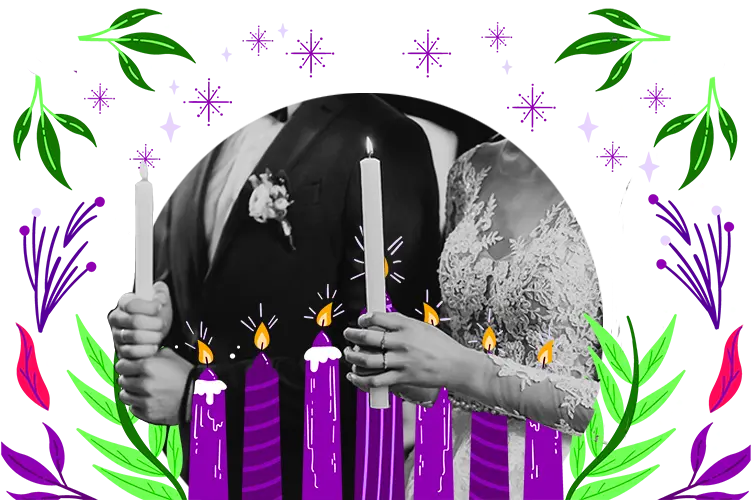
Many people think that nonreligious or nontraditional ceremonies are always brief and simple, but that’s untrue. While removing religious elements can help keep your wedding short and sweet, it doesn’t have to be that way.
Non-Religious ceremonies can be full of symbolism, meaning, and pageantry. One of the best ways to make any wedding more impactful is to include a Unity Ceremony.
Today we’re looking closely at Unity Ceremonies – we’ll explore their backstory and share our favorite ideas and tips. So keep reading and get ready to have a personalized ceremony that you and your guests will adore.

A Unity Ceremony is a unique way to express your union. Some are rooted in religion or culture, while others are used as a way to replace religious traditions.
A Unity Ceremony represents certain aspects of your marriage: new beginnings, interconnectedness, and commitment. You may include one ritual in your wedding or have multiple ones.
You’ve maybe seen couples include a unity candle or sand pouring at weddings – those are common examples of Unity Ceremonies. We’ll highlight several examples below so you can see which might be right for your big day.
You can include your Unity Ceremony whenever you want. “When thinking of having a unity ceremony,” Mariah Wall, Photographer, says, “consider what bonds you as a couple, as a great starting point to add something meaningful.” Then talk with your officiant to see if they have ideas for when it will be the most impactful.
It can replace traditional moments in the wedding – for example, if you don’t want a processional, ring exchange, or prayer. Or your Unity Ceremony can be done in addition to those elements.
If you are including one Unity Ceremony in your wedding, it typically works best toward the end of the ceremony. However, if it’s the most essential part of the wedding for you, you may want to include it toward the beginning or in the middle.
Some people even have additional Unity Ceremony moments at the reception or in private before or after the ceremony. Some couples may add a tea ceremony earlier in the day or read letters to each other in solitude. They may release a lantern or pour a drink at dinner.
Consider how your guests will feel about the Unity Ceremony and when you’ll be able to enjoy it the most.
Unity Ceremonies come in all shapes and sizes. They may be simple or intricate, short or long. They may include only the couple or family as well, and they may be traditional or trendy. That’s the great thing about these ceremonies – they can be customized to fit every couple.
We’ve put together our favorite ideas for Unity Ceremonies. Incorporate them into your wedding, or use them as a launchpad to think of your own unique ideas.
A Unity Candle or Sand Pouring are two of the most common Unity Ceremonies at weddings. For a Unity Candle, the couple starts with two separately lit candles and then lights the third candle together.
The ritual represents two lives becoming one. It’s quick and easy but may not be allowed at all venues.

A Sand Ceremony is a common alternative to the traditional Unity Candle. Each partner begins with their vase or vial of sand, and then they pour it into one vase. The sand blends together to represent the blending of lives.
Use colored sand to see your separate hues blend in the new vase. It is also a nice keepsake to display next to your wedding photos.

Allow your marriage to grow and flourish with a tree-planting ceremony. You can do a small tree, a shrub, a house plant – anything that you think will look nice in your home.
This is a really great choice if you are having a backyard wedding, as you can plant the tree right where you’ll want it to grow. Otherwise, you can do this in a keepsake pot at your wedding venue.
If you don’t want to risk getting dirty, watering a plant is a great way to incorporate this tradition in a tidy way.
It’s an expression nearly as old as marriage itself: Tying the Knot. And it’s a wonderful symbol for creating a strong bond in your marriage. Take the metaphor further by tying the knot in your wedding ceremony. Use strong rope and a good knot, like a fisherman’s knot.
For a more traditional take on knot tying, perform a handfasting ceremony. An officiant or family member will use a cord, ribbon, or cloth to tie your hands together. It’s a Pagan and Wiccan ritual that’s becoming more common in modern weddings, and it’s also done at engagement parties.
Make things really interesting by remaining bound throughout the reception, or slip out of the cords when you’re ready, leaving the knot in place and maintained as a keepsake.

A time capsule is a multi-faceted approach to unity rituals. You and your partner can each gather mementos of your relationship and things representing your hopes for the future. It’s a great way to slow down and reflect leading up to the wedding day.
You can create a display to the side of the altar that includes all your items, so it’s also something nice for your guests to see. As an extra bonus, include love letters that you’ll only read upon the box’s opening.
You two or the officiant can highlight and explain a couple of the items you include in the box. You two can pack everything up and then seal it during the ceremony.
Decide a date when you’ll open your capsule. 10, 15, or 20 years is typically great, though you may opt to open it sooner if you move often and will have difficulty keeping up with it. Aim for 50 if you want to be really ambitious.
It also will serve as an anniversary gift to yourselves years down the road.

A Tea Ceremony is a classic tradition that many Chinese couples include in their wedding, even if they are keeping things simple. This can be done briefly during the marriage or as a full ceremony earlier in the day.
Couples from around the world also include drinks in their Unity Ceremonies. Some blend wine at the altar that they drink together, and modern couples may pour a shot or mix a cocktail.
This is a great way to include your personalities in the ceremony. Make it as formal or fun as you like.

Your officiant can lead you in your Unity Ceremony, but these rituals are also a great way to get your guests involved in the wedding.
A loved one can prepare a reading that introduces your unity candle, or your closest friends can assist you in your tree planting. Parents and grandparents will often tie knots as part of the handfasting ceremony. A special guest can be symbolically responsible for keeping your time capsule, even if you and your partner are ultimately the ones who store it away.
You can also include your guests by putting unique spins on traditional ceremony elements. For example, you can have everyone pass your rings before you exchange them. Or you can seat everyone in a circle around you instead of in rows.
These special touches will bring your guests emotionally closer to the ceremony and allow you to appreciate their presence.
Unity Ceremonies can be extra meaningful at elopements. After all, you don’t have to consider guest comfort or attention spans as you complete rituals that are meaningful to the two of you.
Include a knot tying with the officiant, or create a unity cocktail you can toast with at the ceremony.
An elopement is all about you and your partner, so choose symbols and customs you’ll enjoy.

Including a Unity Ceremony is an excellent idea for most weddings. Skip these additions if you want to keep your wedding really quick or if you get nervous easily, as these ideas will have you in front of your guests doing something unique.
But there are many benefits to a Unity Ceremony. Here are some of our favorite reasons to include this in your wedding:
No matter your reason for wanting a Unity Ceremony, it’s sure to be one of the most memorable parts of your wedding day. So remember to enjoy it, make it personal, and mark it as an important part of your union.
With so many meaningful memories behind you and even more great moments ahead, your Unity Ceremony can mark your entry into a new journey as a couple.